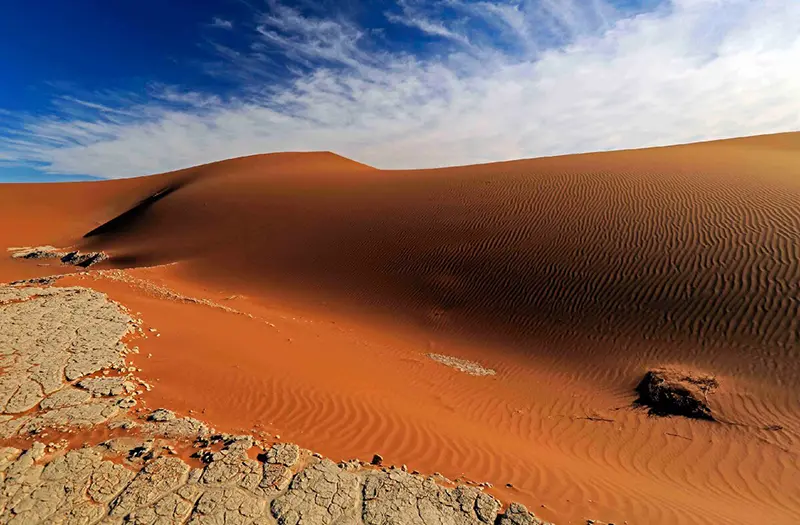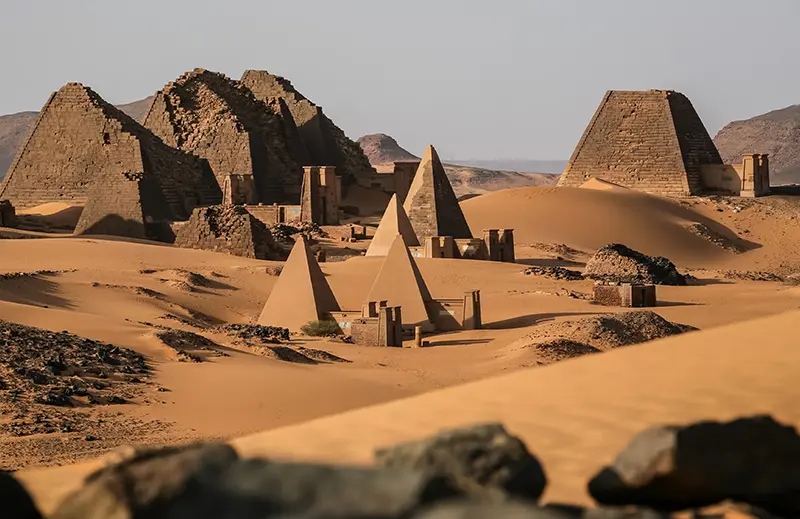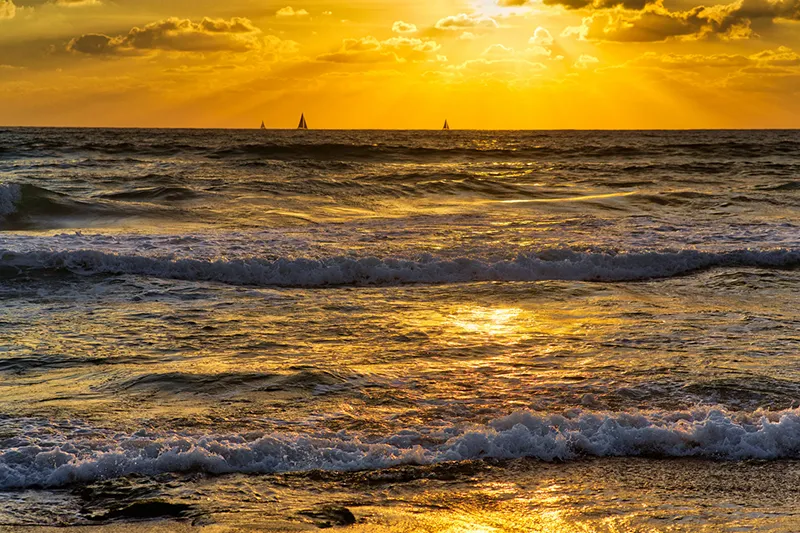The Kalahari Desert is an arid region in southern Africa, covering areas of Botswana, Namibia and South Africa. Despite the name, it is more of a semi-desert with savannahs, rare trees and shrubs. The Kalahari is famous for its red sands, extreme temperature variations and unique fauna including meerkats, oryx and lions. It is home to the San people (Bushmen), one of the oldest ethnic groups on the planet, who maintain a traditional way of life.
Population
When people in Europe began to develop the continent after the Ice Age (about 40 thousand years ago), in South Africa and in the Kalahari already lived the ancestors of modern Bushmen. But if the European world was always pushing people to develop, the desert world required the Bushmen to fully immerse themselves in a subculture of survival that had remained unchanged for centuries.
Europeans nicknamed the Bushmen “bushmen” “people (of) the bush”. Another name for this group of peoples is Gottentots, from the Dutch doubling of consonants, which is due to the unique feature in this language to pronounce sounds with pressure. In South Africa, they are called “San” “outsider”. But in the politically correct world already and there is used the self-name of one of the tribes of the Khoikhoi, which literally can be translated as “people of the people”, “real people”. It is interesting that they, having settled in ancient times throughout Africa, are not just a special race, but, there is a point of view, one of the ancestors of modern man as such.
Bushmen are characterized by a low height (150 cm on average), a broad and flat face, light-copper skin color. Gradually they were displaced from their habitats by negroid Bantu tribes, and in the XVII-XIX centuries. European colonists destroyed about 200,000 koi.
The Kalahari Desert has become the Bushmen’s last refuge. Their feet are replaced by the automobile, their eyes by the Internet, their poisoned arrows by the Kalashnikov assault rifle. Small communities, about 30 people each, lead a nomadic lifestyle. As many centuries ago, their main occupations are hunting and gathering. But it would be a mistake to consider their way of life primitive. They have a vast knowledge of nature, especially the nature of the desert.
The clothing of the Bushmen is loincloths and skins. Men hunt with bows and arrows, the tips of which are poisoned with poison that paralyzes the victim’s nervous system. Women know how to recognize about 60 kinds of edible berries, seeds, bulbs, tubers, leaves. Bushmen’s delicacy is fried locusts and “Bushmen rice” ant larvae. In the dry season, these children of the desert dig a hole in the place of a dried-up spring, stick a long tube into it and, pulling water out of it with their mouths, spit it out into the shell of an ostrich egg. An important source of water is the wild tsamma melon. In the most extreme circumstances, the Bushmen obtain water from the stomachs of shot antelopes.
The Bushmen could, if they had such a fantastic opportunity, create a Desert Academy. But the number of potential academicians is dwindling: only a few thousand Bushmen now live in the Kalahari Desert.
In December 2005, Bushman Roy Cezanne, head of the Botswana-based NGO First People of the Kalahari, was awarded the “Alternative Nobel Prize” for “resolute resistance to the eviction of the Bushmen from their homelands and defense of their right to a traditional way of life.” But most Bushmen work on farms. Attempts to preserve the traditions of life in the desert, to stop the course of history, even in the Kalahari, can hardly compete with a world that does not tolerate white spots on the map and increasingly subordinates people to the universal values of civilization.
History and geography
About 65 million years ago, South Africa was covered by volcanic lava flows up to eight kilometers deep. The Kalahari remains today a natural fire element. During the dry season in August and September, there is virtually no water on its surface. Here, even for South Africa, is the hottest Africa with temperature peaks of up to +42°C.
Most of the world’s place names were not given by poets, but by explorers by nature. The word “Kalahari” most likely came from the Botswana word “curry-carry” – “thirsty”. Bantu tribes living on the borders of the desert add to its name the epithet “kho-fu” – “terrible”. And all other variants of the origin of the name are reduced to the idea of “the land without water” (“Kgalagadi”). The concept of “desert” most often carries a negative meaning. But for nature it is a natural combination of geographical circumstances. Each desert has its own unique world. And any disruption of the biological balance due to increased heat or humidity can lead to unpredictable consequences. And the immutability and slowness of its life look so only at first glance.
The Kalahari draws its own map, which almost completely covers Botswana, occupies a large part of South Africa and Namibia, and is gradually encroaching more and more into the territories of Angola, Zimbabwe and Zambia.
The Kalahari sands once covered the ancient Lake Makgadikgadi, which began to disappear 10,000 years ago. Lost among them are the traces of the four rivers Molopo, Kuruman, Nosob and Aoob. Only in the period of heavy rains their dried-up beds are filled with water.
The red hues of the Kalahari sands are due to the iron oxides in its composition. The dunes formed by it are called “red fingers of the Kalahari”. They are located, as a rule, in chains at a distance of 70-150 meters from each other. And squeeze between them the life of desert inhabitants, dictating to them the rules of behavior.
Flora and fauna
Mammals meerkats and other swarming animals early in the morning and closer to the evening have time to find food, and then hide in burrows one and a half meters deep and deeper. Sulphurs, bubalas, duikers and other small antelopes feed on the long-leaved grass growing between the dunes.
The Kalahari is transformed into savannah by the Okavango River. This 1,600 km long river does not flow into any sea and forms the world’s largest inland delta on land (15,000 km2). It enters the Kalahari and is lost in its northwest in the marshlands. The diversity of flora and fauna here is such that the Moremi Game Reserve in Botswana can be considered one of the richest places where nature shows itself in all its beauty and diversity. Here you can see white elephants, buffaloes, giraffes, lions, leopards, cheetahs, hyenas and jackals, crocodiles and hippos, antelopes of all kinds and sizes. In addition, Moremi is home to 30% of the world’s entire wild dog population.
The Kalahari does not appear to be explored and predictable. Now its sands are anchored and contained by plants, but the “red fingers” of the desert can become a clenched “fist” of long “arms” that can shatter the familiar human world.
General Information
- A desert in South Africa.
- Countries where the Kalahari is located: Botswana, South Africa, Namibia (there are also Kalahari areas in Angola, Zimbabwe, Zambia).
- Ethnic composition: Bushmen (San), Bantu.
- The largest cities: Gabarone, Maun, Ganei.
- The largest river: Okavango.
- Largest lakes: saline lakes Sowa and Ntwetwe in the Desolation Basin, Makgadikgadi, Tskau, Ngami.
- Flora: typical – cereal grasses, shrubs, semi-shrubby low-growing umbrella acacia.
- Fauna: typical animals: chamois, meerkats (a type of mongoose), lions, including the black-horned lion (endemic to the Kalahari, but it is a color variation of the common African lion), various species of antelopes, hyenas, jackals, honey-eater; rodents – dwarf gerbil, short-eared gerbil, ground squirrel; birds – African ostrich, lark, African loggerhead (sandpiper); lizards.
- In the Moremi Reserve: antelopes (gazelles, springboks, impalas, kudu, bushboks, waterboks, puku and gnu antelopes), elephants, giraffes, hippos, buffalo, lions, cheetahs, hyenas, jackals, leopards, baboons, 400 species of birds.
- In the Central Kalahari Reserve: zebras, lions, various species of antelope, leopards, warthogs and other animals.
- On the salt marshes of the Makgadikgadi Pans Reserve: during the rainy season: flamingos and other waterfowl.
- Nearest airport to Moremi Game Reserve: in Maun (Botswana), where airplanes arrive from Johannesburg International Airport (South Africa).
- Area: about 600,000 km2. (80% in Botswana).
- Okavango River Delta: about 17,000 km2.
- National parks: Gemsbok, Kalahari Gemsbok, Chobe, Ntskai-Pan, Kgalagadi, “Augrabis Falls”.
- Reserves: Makgadikgadi Pans, Central Kalahari, Mabuasehube, Moremi with the Okavango River delta, the delta is a UNESCO World Natural Heritage Site.
Climate and weather
- Arid – dry, tropical.
- Average minimum temperature: +12ºC, average maximum: +29ºC.
- Average annual rainfall: Ranges from 270 mm (south) to 500 mm (north) in the Okavango Delta.
- Rainy season: November to April.
Economy
- Mining: mining of diamonds, nickel, bronze, potash, salt.
- Agriculture: cultivation of melons, cattle breeding.
- Service sector: tourism.
Fun Facts
- The ritual dance of Bushmen is dedicated to tsamma melons, during which they clap their hands quickly and rhythmically, pound the ground frantically with their bare heels, and make shrill sounds. And after performing these movements in the center of the circle, the dancer throws the melon to another dancer who continues its performance.
- The emergence of the Kalahari is associated with strong southwestern winds from the Namib Desert.
- The “singing sands” are found in the Kalahari. Legends tell that this is how evil spirits imprisoned under the ground sing, the sound of drifted human settlements. Scientists have not found an answer to all the questions related to the occurrence of such an unusual phenomenon, to decipher the secret meaning of their “songs” man may not be given. This natural phenomenon is vividly described by Jack London in his novel “Hearts of Three”: “Every step on the sand caused a cacophony of sounds. People froze on the spot – and everything stopped around it was worth to make a step and the sand again began to sing … – When the gods laugh, beware! – cried out the old man. He drew a circle on the sand, and while he was drawing, the sand howled and squealed; the old man knelt down – the sand roared and trumpeted….”
- “The gods must have gone mad” This is the title of a movie made in 1980. Its main character Hiko, a Bushman, found a Coca-Cola bottle in the desert. This discovery disrupts the usual life of the primitive tribe. Hiko decides to take it to the edge of the world, experiencing along the way many encounters and adventures with modern civilization. But in the end he returns home. Interestingly, the actor who played Hiko, a real Nixau Bushman, has traveled roughly the same path in life.
- The Kalahari has a considerable supply of water, but it is about 300 meters deep.
- The Kalahari is so mysterious that fantasists looking out for UFOs have high hopes with it. In particular, there is top secret information that on May 7, 1989 the South African Air Force managed to shoot down a UFO over the Kalahari Desert.
- Augrabies Falls National Park (South Africa) is famous for its water “cauldron”. The Orange River, passing along the southern border of the desert, falls here in a narrow stone gap, hits the rocky bed, raising a column of water dust height of 100 meters. A rainbow constantly hangs over Augrabis, and its rumble can be heard for many kilometers around.




